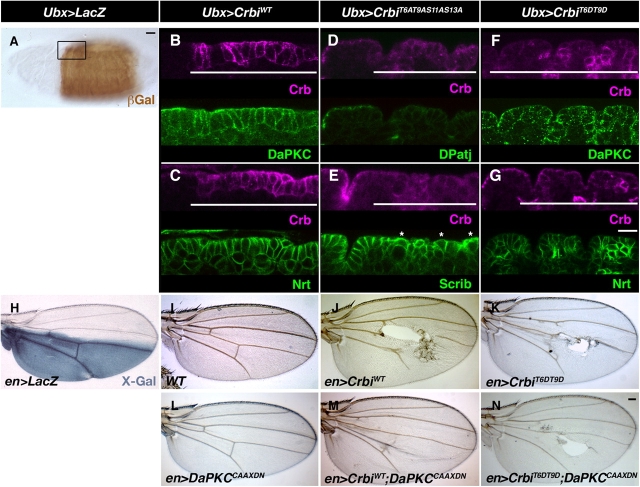Figure 4.
Regulation of Crbi activity by DaPKC-dependent phosphorylation. Different forms of Crbi were overexpressed in embryos (B–G, Ubx-Gal4 line) and in the wing disc (J–N, en-Gal4 line). (A) Embryos expressing UAS-LacZ under the control of Ubx-Gal4 line were stained with anti–β-galactosidase antibody to reveal the domain of expression of the Ubx-Gal4 line. Similar regions to the one marked in A are shown in B–G. In these panels, the extent of the Ubx-Gal4 expressing domain is indicated by the white bar. (B–G) Embryos of the indicated genotype were stained with an antibody raised against the intracellular domain of Crb to reveal the distribution of both the endogenous and overexpressed Crb (purple) and costained (green) for DaPKC (B and F), Nrt (C and G), Patj (D), and Scrib (E). (B and C) Embryos expressing wild-type Crbi showed extensive relocalization of DaPKC to the whole cell contour in the cells overexpressing Crb (B). The localization of the basolateral marker Nrt was not affected (C). (D and E) On the contrary, overexpression of Crbi T6AT9AS11AS13A was associated with loss from the apical membrane of Crb and Patj (D) and with ectopic apical localization of Scrib (E, asterisks). (F and G) Overexpression of Crbi T6DT9D caused, similarly to Crbi, relocalization of DaPKC to the whole cell cortex (F) without affecting Nrt distribution (G). (H) en-gal4/UAS-LacZ wing stained with X-gal to show (blue) the posterior compartment of the wing. (I–N) Wild-type (I) and mutant wings expressing the indicated UAS transgenes driven by en-Gal4 (J–N). Overexpression of UAS-Crbi WT (J) or UAS-Crbi T6DT9D (K) causes strong cuticular defects. Overexpression of UAS-DaPKC CAAXDN does not affect wing cuticle deposition (L) but its coexpression suppresses the dominant phenotype of UAS-Crbi WT (M) but not that of UAS-Crbi T6DT9D (N). Bars: (A) 20 μm; (G, small white bar) 10 μm; (N) 10 μm.

